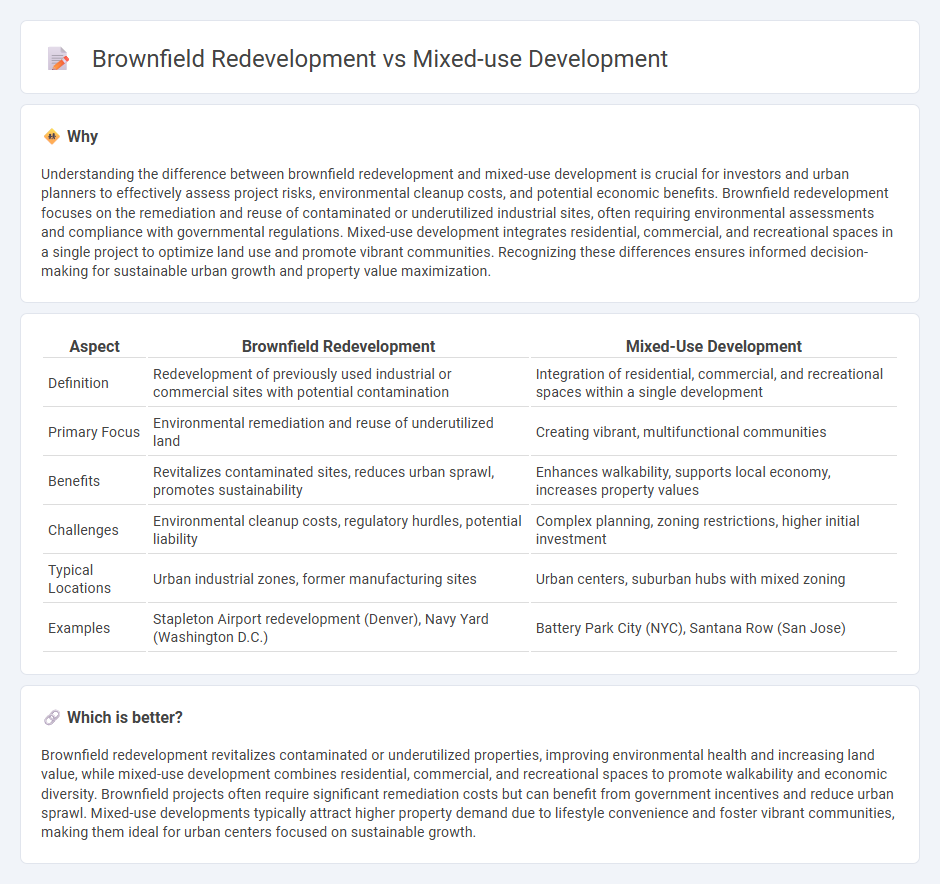
Brownfield redevelopment focuses on transforming previously contaminated or underutilized industrial sites into valuable real estate, often requiring environmental remediation and regulatory approvals. Mixed-use development integrates residential, commercial, and recreational spaces within the same project to create vibrant, walkable communities that maximize land use efficiency and enhance urban living. Explore the benefits and challenges of these development strategies to understand their impact on sustainable city growth.
Why it is important
Understanding the difference between brownfield redevelopment and mixed-use development is crucial for investors and urban planners to effectively assess project risks, environmental cleanup costs, and potential economic benefits. Brownfield redevelopment focuses on the remediation and reuse of contaminated or underutilized industrial sites, often requiring environmental assessments and compliance with governmental regulations. Mixed-use development integrates residential, commercial, and recreational spaces in a single project to optimize land use and promote vibrant communities. Recognizing these differences ensures informed decision-making for sustainable urban growth and property value maximization.
Comparison Table
| Aspect | Brownfield Redevelopment | Mixed-Use Development |
|---|---|---|
| Definition | Redevelopment of previously used industrial or commercial sites with potential contamination | Integration of residential, commercial, and recreational spaces within a single development |
| Primary Focus | Environmental remediation and reuse of underutilized land | Creating vibrant, multifunctional communities |
| Benefits | Revitalizes contaminated sites, reduces urban sprawl, promotes sustainability | Enhances walkability, supports local economy, increases property values |
| Challenges | Environmental cleanup costs, regulatory hurdles, potential liability | Complex planning, zoning restrictions, higher initial investment |
| Typical Locations | Urban industrial zones, former manufacturing sites | Urban centers, suburban hubs with mixed zoning |
| Examples | Stapleton Airport redevelopment (Denver), Navy Yard (Washington D.C.) | Battery Park City (NYC), Santana Row (San Jose) |
Which is better?
Brownfield redevelopment revitalizes contaminated or underutilized properties, improving environmental health and increasing land value, while mixed-use development combines residential, commercial, and recreational spaces to promote walkability and economic diversity. Brownfield projects often require significant remediation costs but can benefit from government incentives and reduce urban sprawl. Mixed-use developments typically attract higher property demand due to lifestyle convenience and foster vibrant communities, making them ideal for urban centers focused on sustainable growth.
Connection
Brownfield redevelopment transforms contaminated, underutilized industrial sites into viable properties, often integrated with mixed-use development to maximize land value and community benefits. Mixed-use projects combine residential, commercial, and recreational spaces, fostering vibrant neighborhoods and reducing urban sprawl by repurposing brownfield sites. This synergy enhances sustainable urban growth, mitigates environmental risks, and attracts diverse economic activities in real estate markets.
Key Terms
**Mixed-Use Development:**
Mixed-use development integrates residential, commercial, and recreational spaces within a single project, promoting urban density and walkability while reducing reliance on automobiles. This approach maximizes land use efficiency, supports local economies, and fosters vibrant community interactions. Explore the benefits and design strategies of mixed-use development to better understand its impact on sustainable urban growth.
Zoning
Mixed-use development integrates residential, commercial, and recreational spaces within a single zone, fostering urban density and diverse land use. Brownfield redevelopment focuses on rehabilitating previously industrial or contaminated zones under strict environmental zoning regulations to encourage sustainable urban renewal. Explore zoning strategies that shape these approaches for a deeper understanding of urban planning dynamics.
Vertical Integration
Mixed-use development integrates residential, commercial, and recreational spaces within a single vertical complex, optimizing land use and promoting urban density. Brownfield redevelopment involves the cleanup and repurposing of contaminated or underutilized industrial sites, often requiring extensive environmental remediation before vertical integration can occur. Explore the advantages and challenges of vertical integration in both development types to understand their impact on sustainable urban growth.
Source and External Links
Supporting Active Living Through Mixed-Use Developments - Mixed-use development blends multiple uses such as residential, commercial, and civic spaces within walking distance, encouraging physical activity and offering environmental, economic, social, and health benefits while requiring community engagement for equitable implementation.
Benefits of Mixed-Use Development in Urban Areas - McClure - Mixed-use developments combine residential, commercial, and sometimes industrial spaces in one area to optimize land use, foster vibrant communities, ensure accessibility, and provide diverse community-oriented spaces.
Mixed-use development - Wikipedia - Mixed-use development is an urban planning approach that integrates residential, commercial, cultural, or institutional uses physically and functionally in one space, facilitating pedestrian connections and can apply from single buildings to entire neighborhoods.
 dowidth.com
dowidth.com